ECU CHEVROLET ASTRO 2003 User Guide
[x] Cancel search | Manufacturer: CHEVROLET, Model Year: 2003, Model line: ASTRO, Model: CHEVROLET ASTRO 2003Pages: 386, PDF Size: 17.31 MB
Page 55 of 386
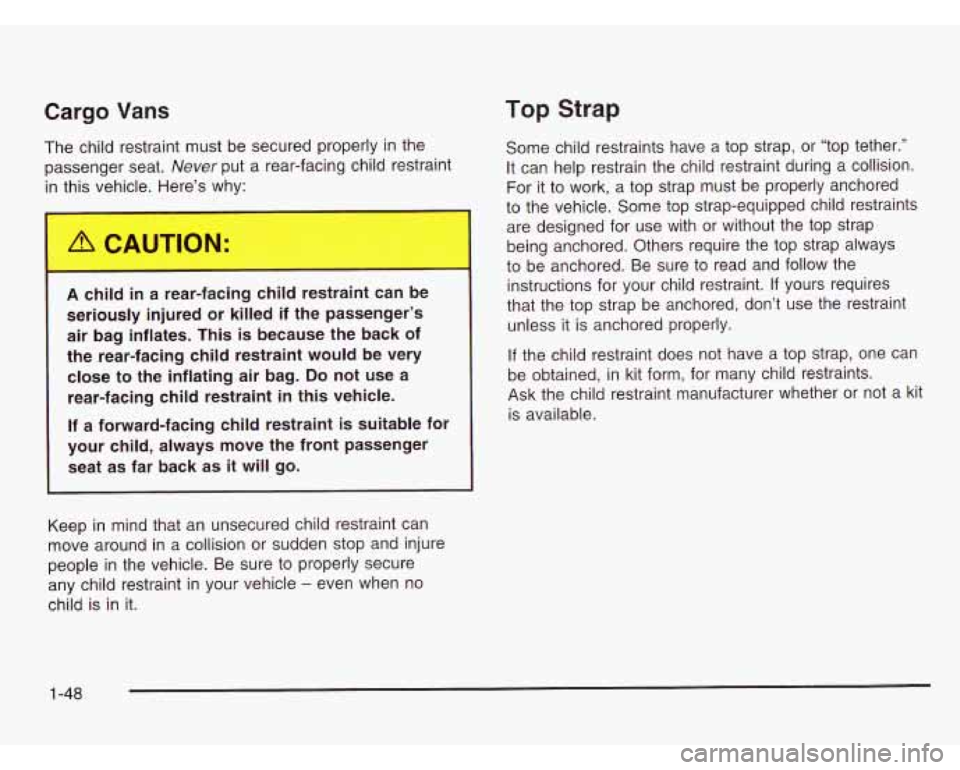
Cargo Vans Top Strap
The child restraint must be secured properly in the
passenger seat.
Never put a rear-facing child restraint
in this vehicle. Here’s why:
A child in a r- r-fa 1g child restraint can be
seriously injured or killed if the passenger’s
air bag inflates. This
is because the back of
the rear-facing child restraint would be very close to the inflating air bag.
Do not use a
rear-facing child restraint
in this vehicle.
If a forward-facing child restraint is suitable for
your child, always move the front passenger
seat as far back as
it will go.
Keep
in mind that an unsecured child restraint can
move around in a collision or sudden stop and injure
people
in the vehicle. Be sure to properly secure
any child restraint in your vehicle
- even when no
child is in it. Some
child restraints have a top strap, or “top tether.”
It can help restrain the child restraint during a collision.
For it to work, a top strap must be properly anchored
to the vehicle. Some top strap-equipped child restraints
are designed for use with or without the top strap
being anchored. Others require the top strap always
to be anchored. Be sure to read and follow the
instructions for your child restraint.
If yours requires
that the top strap be anchored, don’t use the restraint
unless it is anchored properly.
If the child restraint does not have a top strap, one can
be obtained, in kit form, for many child restraints.
Ask the child restraint manufacturer whether or not a kit
is available.
I -48
Page 56 of 386
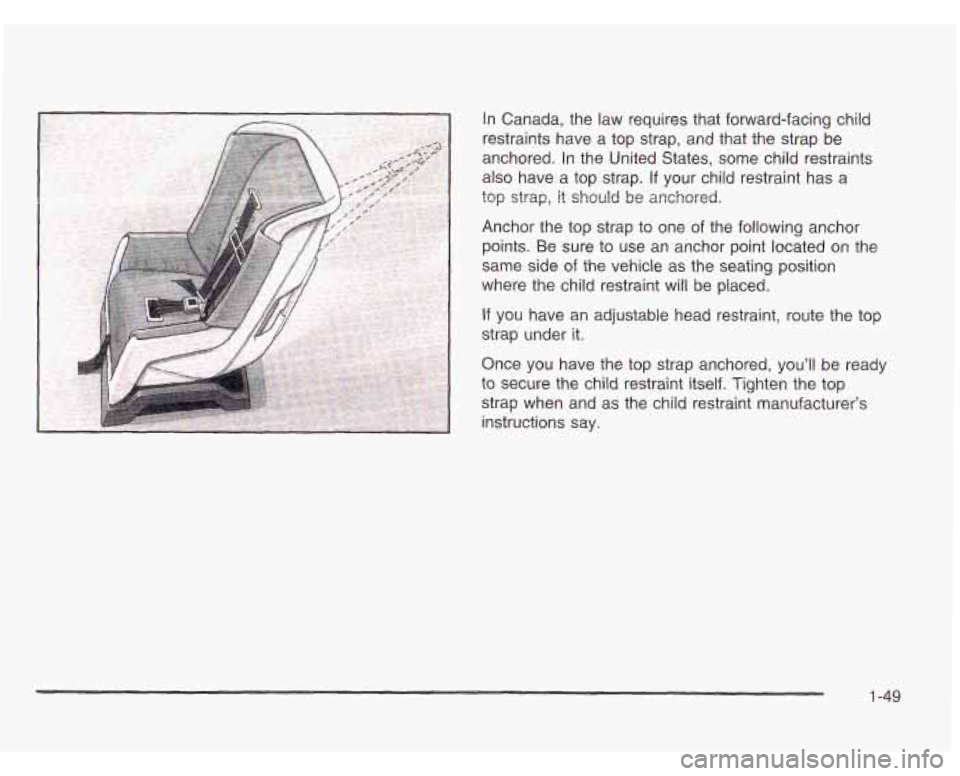
In Canada, the law requires that forward-facing child
restraints have a top strap, and that the strap be
anchored. In the United States, some child restraints
also have a top strap.
If your child restraint has a
top strap, it should be anchored.
Anchor the top strap to one of the following anchor
points. Be sure to use an anchor point located on the
same side
of the vehicle as the seating position
where the child restraint will be placed.
If you have an adjustable head restraint, route the top
strap under it.
Once you have the top strap anchored, you’ll be ready
to secure the child restraint itself. Tighten the top
strap when and as the child restraint manufacturer’s
instructions say.
1-49
Page 57 of 386
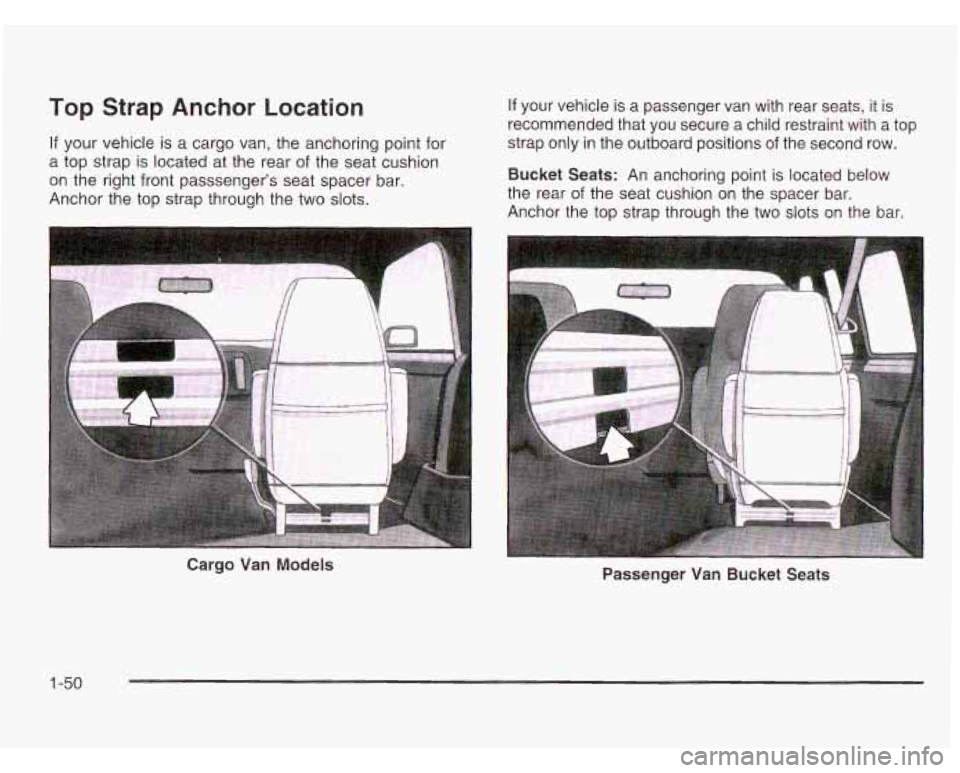
Top Strap Anchor Location
If your vehicle is a cargo van, the anchoring point for
a top strap is located at the rear
of the seat cushion
on the right front passsenger's seat spacer bar.
Anchor the top strap through the two slots.
If your vehicle is a passenger van with rear seats, it is
recommended that you secure a child restraint with a top
strap only in the outboard positions of the second row.
Bucket Seats: An anchoring point is located below
the rear of the seat cushion on the spacer bar.
Anchor the top strap through the two slots on the bar.
Cargo Van Models
Passenger Van Bucket Seats
1 -50
Page 60 of 386
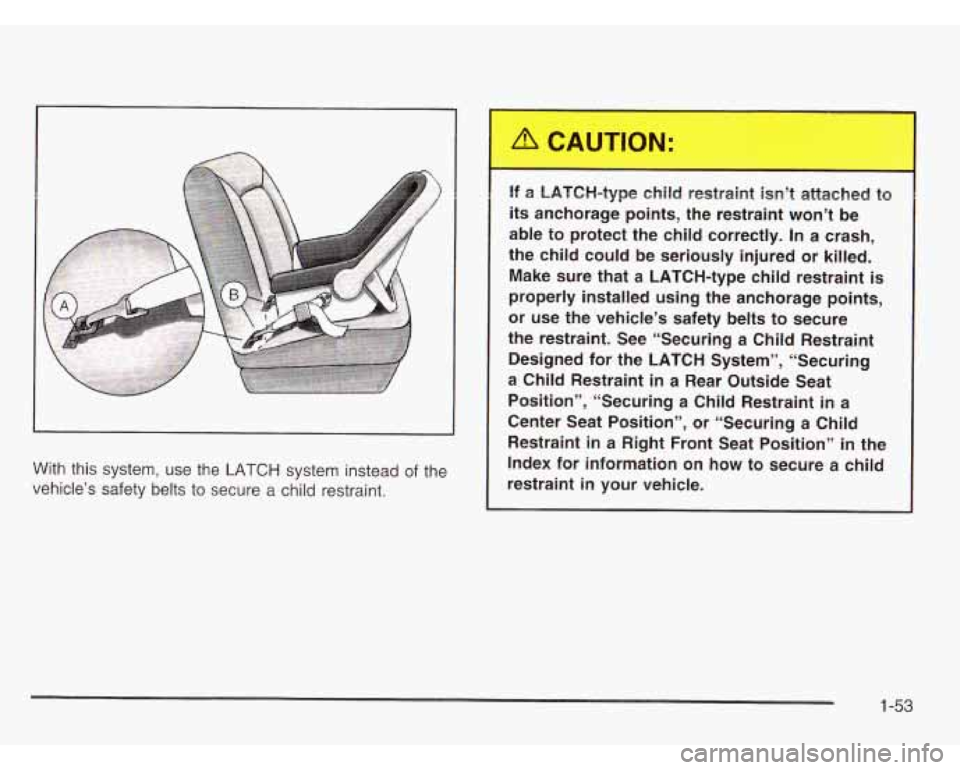
With this system, use the LATCH system instead of the
vehicle’s safety belts to secure a child restraint. If a LATCH-type
child restraint isn’t attached t~
its anchorage points, the restraint won’t be
able to protect the child correctly.
In a crash,
the child could be seriously injured or killed.
Make sure that a LATCH-type child restraint
is
properly installed using the anchorage points,
or use the vehicle’s safety belts to secure
the restraint. See “Securing a Child Restraint
Designed for the LATCH System”, “Securing
a Child Restraint
in a Rear Outside Seat
Position”, “Securing a Child Restraint
in a
Center Seat Position”, or “Securing a Child
Restraint
in a Right Front Seat Position” in the
Index for information on how
to secure a child
restraint
in your vehicle.
1-53
Page 61 of 386
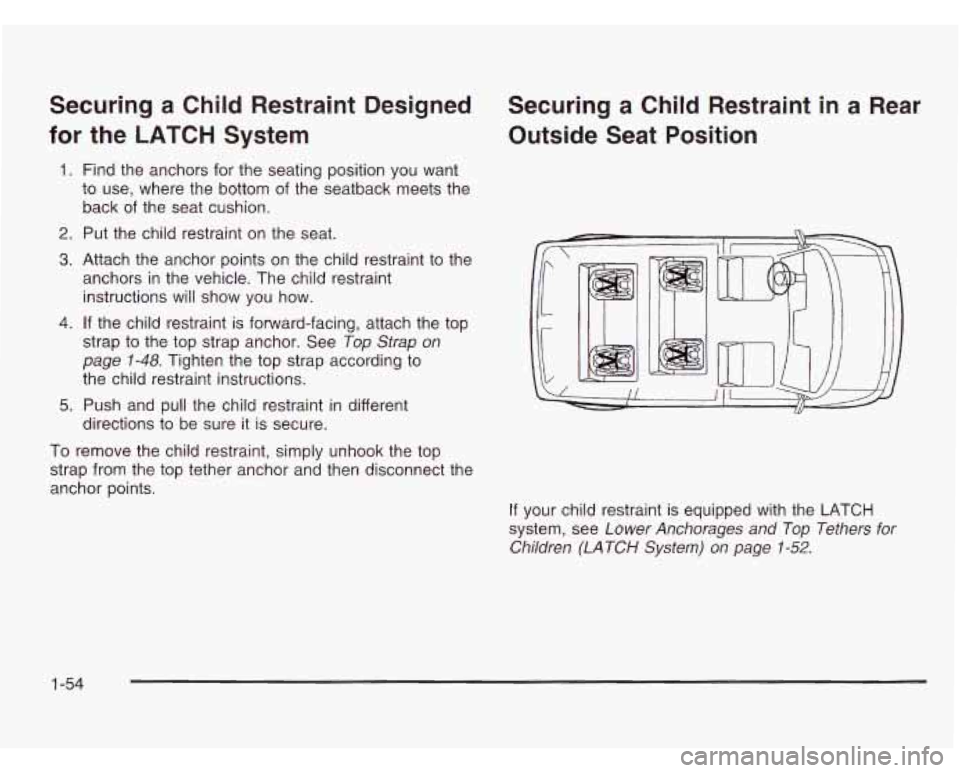
Securing a Child Restraint Designed Securing a Child Restraint in a Rear
for the
LATCH System
Outside Seat Position
1. Find the anchors for the seating position you want
to use, where the bottom of the seatback meets the
back
of the seat cushion.
2. Put the child restraint on the seat.
3. Attach the anchor points on the child restraint to the
anchors in the vehicle. The child restraint
instructions will show you how.
4. If the child restraint is forward-facing, attach the top
strap to the top strap anchor. See
Top Strap on
page
7-48. Tighten the top strap according to
the child restraint instructions.
directions to be sure it is secure.
5.
Push and pull the child restraint in different
To remove the child restraint, simply unhook the top
strap from the top tether anchor and then disconnect the
anchor points.
If your child restraint is equipped with the LATCH
system, see Lower Anchorages and Top Tethers for
Children (LATCH System) on page
1-52.
1-54
Page 62 of 386
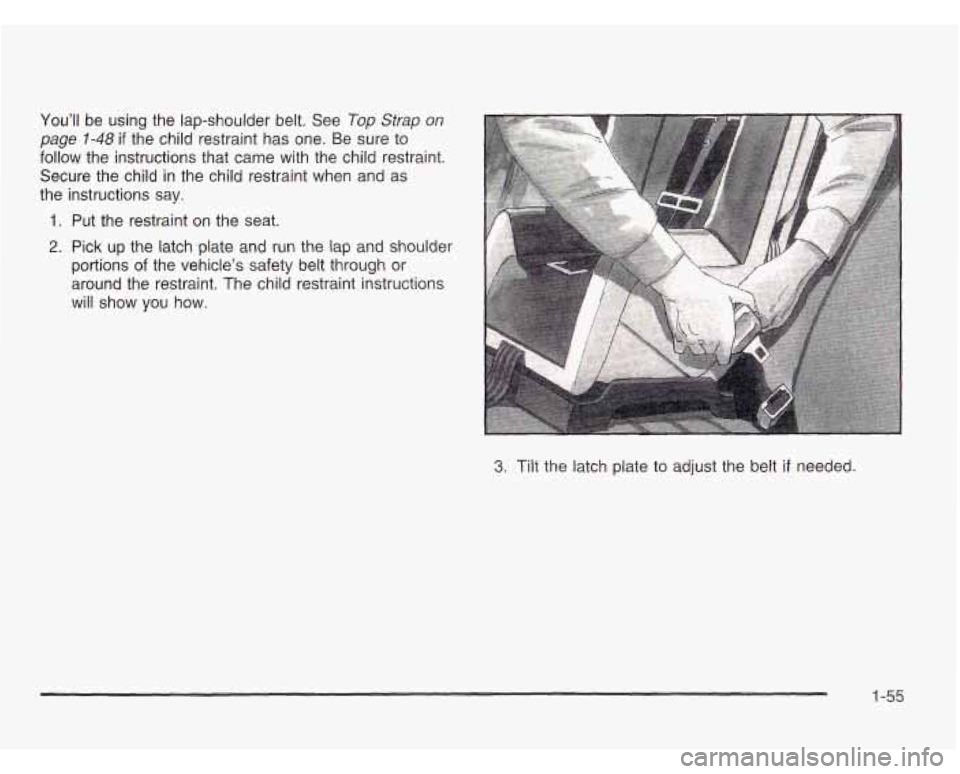
You’ll be using the lap-shoulder belt. See Top Strap on
page 1-48 if the child restraint has one. Be sure to
follow the instructions that came with the child restraint.
Secure the child in the child restraint when and as
the instructions say.
1. Put the restraint on the seat.
2. Pick up the latch plate and run the lap and shoulder
portions
of the vehicle’s safety belt through or
around the restraint. The child restraint instructions
will show you how.
3. Tilt the latch plate to adjust the belt if needed.
1-55
Page 63 of 386
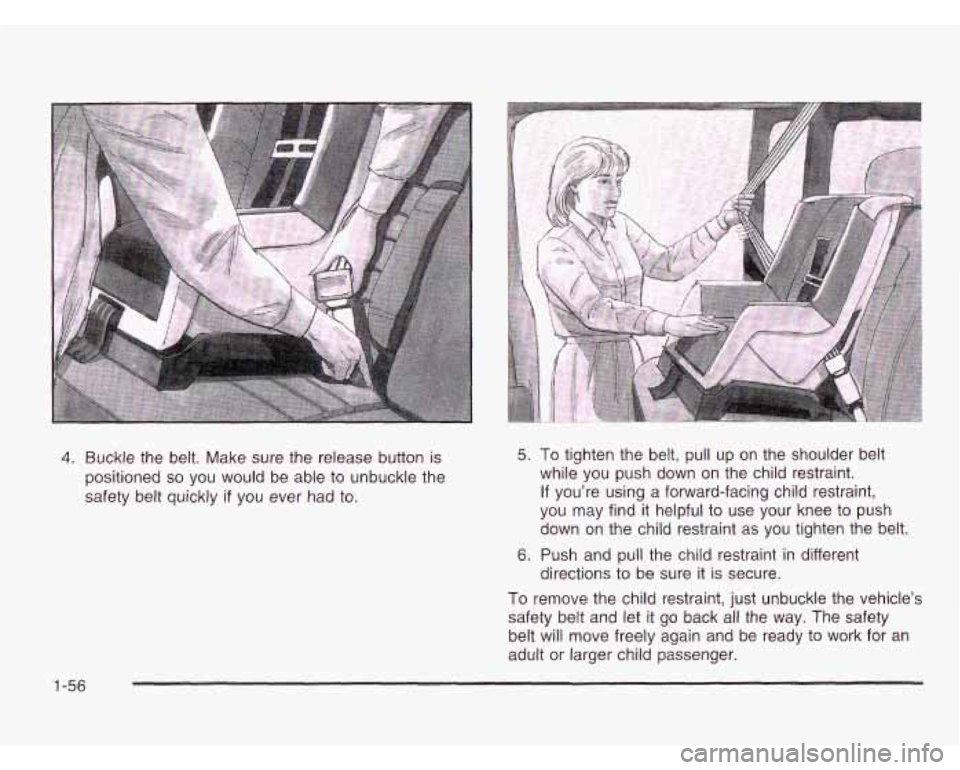
4. Buckle the belt. Make sure the release button is
positioned
so you would be able to unbuckle the
safety belt quickly
if you ever had to.
5.
6.
To tighten the belt, pull up on the shoulder belt
while you push down
on the child restraint.
If you’re using a forward-facing child restraint,
you may find it helpful to use your knee to push
down
on the child restraint as you tighten the belt.
Push and pull the child restraint in different
directions to be sure it
is secure.
To remove the child restraint, just unbuckle the vehicle’s
safety belt and let
it go back all the way. The safety
belt will move freely again and be ready to work for an
adult
or larger child passenger.
1-56
Page 64 of 386
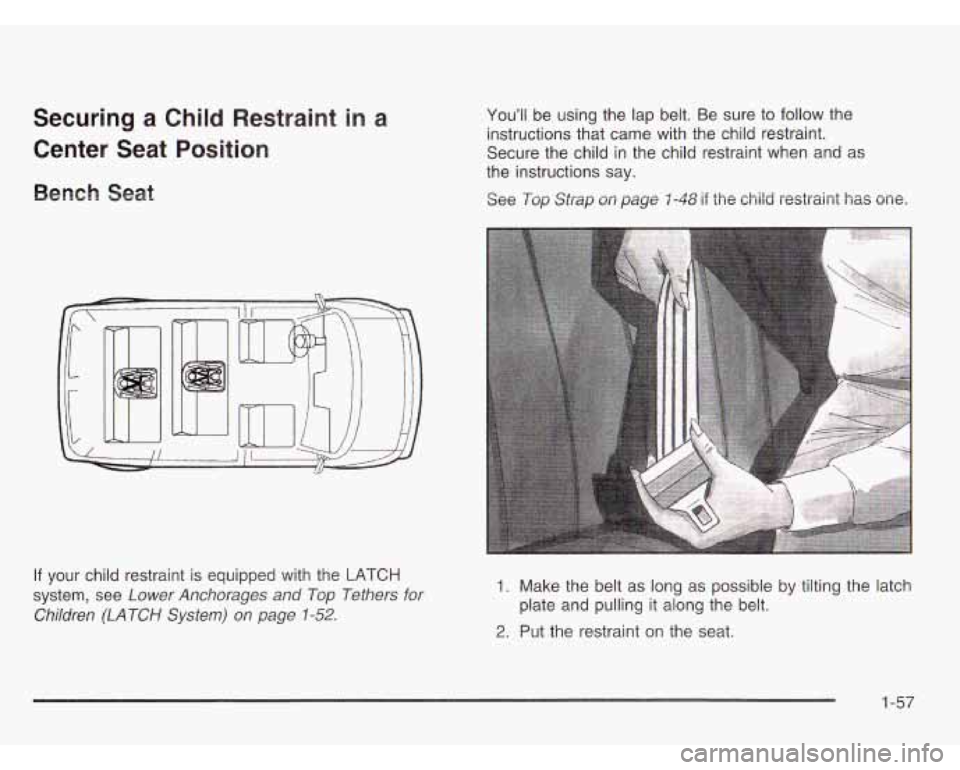
Securing a Child Restraint in a
Center Seat Position
Bench Seat
You’ll be using the lap belt. Be sure to follow the
instructions that came with the child restraint.
Secure the child in the child restraint when and as
the instructions say.
See Top Strap on page 1-48 if the child restraint has one.
If your child restraint is equipped with the LATCH
system, see Lower Anchorages and Top Tethers for
Children (LATCH System)
on page 1-52.
1. Make the belt as long as possible by tilting the latch
2. Put the restraint on the seat.
plate
and pulling it along the belt.
1-57
Page 65 of 386
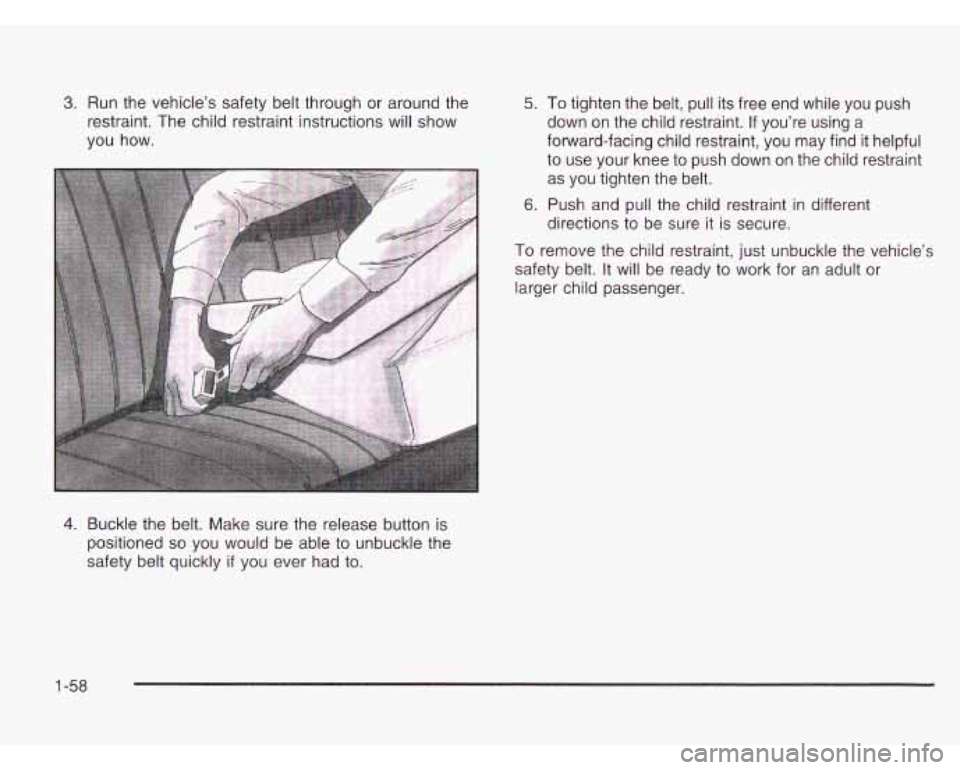
3. Run the vehicle’s safety belt through or around the
restraint. The child restraint instructions will show
you how. 5. To tighten the belt, pull its free end while you push
down on the child restraint. If you’re using a
forward-facing child restraint, you may find it helpful
to use your knee
to push down on the child restraint
as you tighten the belt.
directions
to be sure it is secure.
6. Push and pull the child restraint in different
To remove the child restraint, just unbuckle the vehicle’s
safety belt.
It will be ready to work for an adult or
larger child passenger.
4. Buckle the belt. Make sure the release button is
positioned
so you would be able to unbuckle the
safety belt quickly
if you ever had to.
1-58
Page 66 of 386
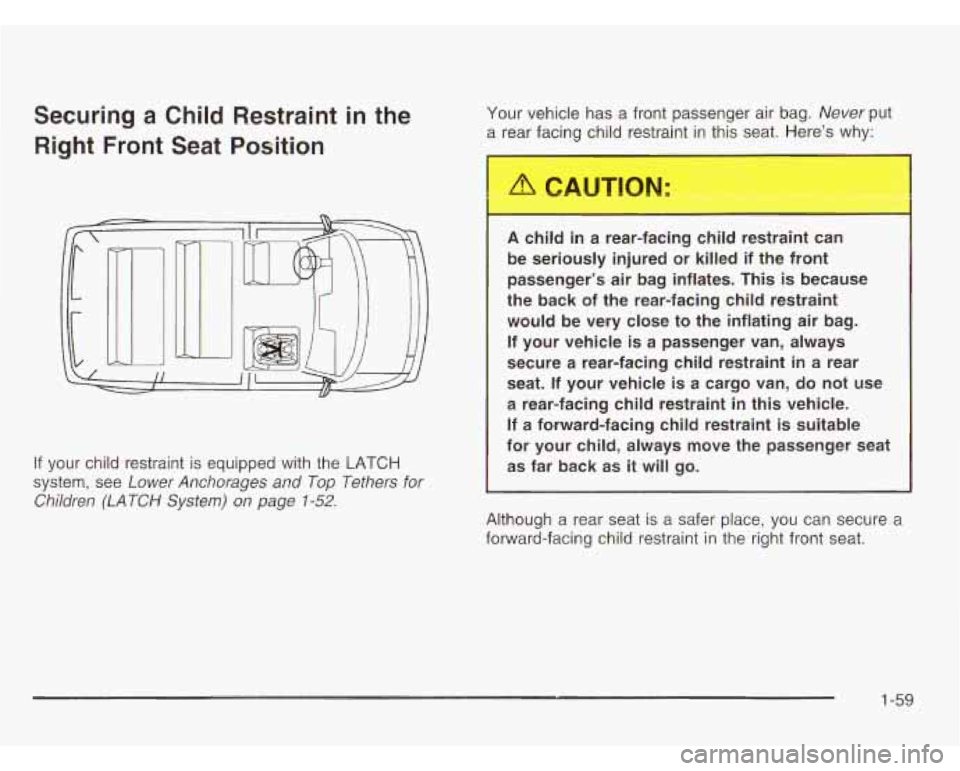
Securing a Child Restraint in the
Right
Front Seat Position
Your vehicle has a front passenger air bag. Never put
a rear facing child restr;
’ t in this seat. Here’s why:
.
If your child restraint is equipped with the LATCH
system, see
Lower Anchorages and Top Tethers for
Children (LATCH
System) on page 1-52.
A child in a rear-facing child restraint can
be seriously injured or killed
if the front
passenger’s air bag inflates. This
is because
the back of the rear-facing child restraint
would be very close
to the inflating air bag.
If your vehicle is a passenger van, always
secure a rear-facing child restraint
in a rear
seat. If your vehicle
is a cargo van, do not use
a rear-facing child restraint in
this vehicle.
If a forward-facing child restraint
is suitable
for your child, always move the passenger seat
as far back as
it will go.
L
Although a rear seat is a safer place, you can secure a
forward-facing child restraint in the right front seat.
1-59